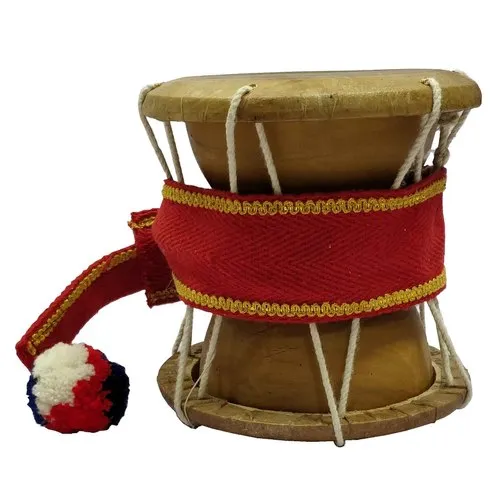Uduku
Percussions
Africa
Between 1001 and 1900 AD
Video
The Udukku, also known as Udukkai, is a traditional percussion instrument originating from South India, particularly popular in Kerala and Tamil Nadu. This hourglass-shaped drum is characterized by its unique construction and the ability to produce a variety of sounds.
The Udukku is typically smaller than the Edakka but larger than the Damaru, making it a versatile instrument in various musical contexts. The Udukku is classified as a membranophone, which means it produces sound primarily through the vibration of a stretched membrane. It is often used in folk music and religious ceremonies, providing rhythmic accompaniment to various performances.
History and Origin
The uduku is an ancient African percussion instrument known for its unique sound and cultural significance. Originating from the Igbo people of Nigeria in West Africa, the uduku traces its roots back to ancient times, likely several centuries before the Common Era. The name “uduku” is derived from the Igbo word for “vessel,” as the instrument’s design closely resembles traditional clay water pots. Historically, the uduku was not only a musical instrument but also a symbol of communal life and spiritual connection. It was used in various ceremonies, including rituals, weddings, and festivals, to invoke harmony and celebration.
The uduku’s design and use have influenced the development of similar instruments across other African regions and even beyond the continent. Its integration into contemporary music genres highlights its enduring appeal and versatility.
Construction
The uduku is crafted from clay, a material chosen for its acoustic properties and cultural significance. Its shape resembles a rounded pot with a narrow neck and a hole on the side. The neck is often elongated to allow for better grip and sound manipulation. The surface of the instrument is typically smooth and may be adorned with carvings, patterns, or paint that reflect the cultural identity of its makers.
The construction process involves molding the clay into the desired shape, allowing it to dry, and then firing it in a kiln to harden the structure. Some variations may include additional holes or grooves to produce distinct tonal qualities. The uduku’s simplicity and reliance on natural materials make it a sustainable and accessible instrument for many communities.
Types of Uduku
Traditional Uduku: These are the original designs used in cultural and ceremonial settings, characterized by their authentic clay construction and minimalist design.
Modern Uduku: These may incorporate synthetic materials or innovative features to enhance durability and sound range.
Decorative Uduku: These are crafted primarily for aesthetic purposes, often featuring intricate designs and vibrant colors.
Amplified Uduku: Designed for use in contemporary music, these instruments may include built-in microphones or pickups to project sound in live performances.
Features
Clay Construction: Provides a warm, resonant sound unique to the uduku.
Side Hole: Allows for varied tonal expressions by manipulating airflow.
Compact Design: Makes it easy to handle and play in diverse settings.
Cultural Significance: Embodies the heritage and traditions of its origins.
Adaptability: Suited for traditional, contemporary, and experimental music genres.
Sound Production
The uduku produces sound through the vibration of air within its hollow chamber. When struck with the palm or fingers, the instrument creates a deep, resonant tone that can be modulated by covering and uncovering the side hole. The combination of striking and air manipulation allows players to achieve a wide range of sounds, from soft, melodic notes to sharp, percussive beats.
The acoustic properties of the clay amplify these vibrations, giving the uduku its characteristic richness and depth. Experienced players can use advanced techniques, such as tapping different parts of the surface or varying the force of their strikes, to create intricate rhythms and textures.
Playing Methods
Playing the uduku requires a blend of rhythm and technique. The instrument is typically played while seated, with the base resting on the player’s lap or a cushioned surface. Players use their hands to strike the body and manipulate the side hole, creating dynamic rhythms and tones.
Key playing techniques include:
Palm Strikes: Producing deep, bass-like sounds by striking the body with the palm.
Finger Taps: Generating higher-pitched tones by tapping with fingers.
Air Manipulation: Covering and uncovering the side hole to vary the pitch and resonance.
Combination Patterns: Blending different strikes and techniques to create complex rhythms.
The uduku’s versatility allows it to be played solo or as part of an ensemble, complementing other instruments and adding depth to musical compositions.
Roles in Music
The uduku plays a vital role in African music, where rhythm and percussion are integral to storytelling, dancing, and cultural expression. In traditional settings, it serves as a rhythmic backbone in ceremonies and festivals, uniting participants through its compelling beats.
In modern music, the uduku has found a place in various genres, including Afrobeat, jazz, and world music. Its unique sound adds a distinctive flavor to contemporary compositions, bridging traditional and modern elements. The instrument is also used in experimental music, where its tonal versatility and aesthetic appeal inspire innovative performances.
The uduku’s role extends beyond music, symbolizing cultural identity and heritage. Its presence in global music scenes reflects the enduring influence of African traditions and their contribution to the world of art and culture.
FAQ
What are some common uses of the Udukku?
The Udukku is commonly used in temple rituals and folk music performances throughout South India. It accompanies traditional songs like Ayyappan Pattu and enhances communal celebrations during festivals.
What features make the Udukku unique?
The Udukku features an hourglass shape that allows for diverse tonal variations. Its adjustable tension mechanism enables musicians to modify pitch during play, making it versatile for both rhythmic and melodic performances.
How does the Udukku contribute to music?
The Udukku plays a significant role in enhancing cultural expressions through music. It serves as an accompaniment in religious ceremonies and folk traditions, fostering community engagement and preserving regional identities.
 Links
Links
References
Other Instrument
Categories


















